 |
|||
|
home february 26 february 27 february 28 february 29 march 1 march 2 march 3 march 4 march 5 reflections bios |
selma to montgomery, the kkk and congressmen by michael simon mbsimon@umich.edu We were given the option last night whether or not we wanted to go to Selma this morning. We were tired and worn down. I, for one, am starting to show the signs of lack of sleep and the beginnings of a cold. Some of us decided to sleep in and get some much-needed rest before going to downtown Montgomery this afternoon. Many of us, however, decided to wake up early and drive approximately an hour down I-80 to Selma. Selma is currently preparing for the visit of President Bill Clinton, who will be speaking at the foot of the Edmund Pettus Bridge tomorrow (Sunday) afternoon. This weekend, you see, is the 35th Anniversary of what has gone down in American history as "Bloody Sunday." In 1965, demonstrators, lead by John Lewis (Chairman of SNCC) and others, planned to march from Selma to Montgomery to protest the lack of voting rights afforded to people of color in the South. When the marchers reached the crest of the Edmund Pettus bridge (from one side, you can not see to the other, due to its incline), they saw Alabama State Troopers lined up - some on horseback, others with billy clubs and tear gas. The troopers, on the command of then Governor George "segregation now, segregation forever" Wallace moved forward into the mass of demonstrators. In an excessive and brutal display of violence, the marchers were beaten and tear gassed. Many had to be hospitalized. John Lewis (now a member of the House of Representatives) had his skull fractured by a blow from an officer's club. The disturbing and violent images were printed in newspapers and shown on television around the world. The actions of law enforcement officials on "Bloody Sunday" were part of the impetus to pass the Voting Rights Act that guaranteed all people of color in the U.S. the right to vote. So off to Selma we went. We only stayed for about 25 minutes or so, but in that short time we walked over the bridge and back, and tried to imagine what it must have been like to come to the top, look down and know that you were going to be beaten severely. But such was the dedication of those people who secured the rights that we now all enjoy. On the way back to Montgomery to meet the rest of our group at the Dexter Avenue Baptist Church just adjacent to the Alabama State Capitol, we read out loud from John Lewis' account of "Bloody Sunday." I got the chills and my emotions were stirred as we crossed the bridge in our van while Debra read about what happened on that exact spot 35 years ago tomorrow. We were off to Montgomery, where the marchers that day intended to go. Instead, they ended up with head wounds, concussions and tear gas burns. I can't feel but feel deep sorrow. Representative John Lewis (D., Georgia), when speaking at U of M a couple of months ago, invited the members of our trip to join his congressional delegation touring Southern Civil Rights sites when they were in Montgomery, as we were to be there at the same time. His group, called the Faith in Politics Tour, was doing basically the same thing that we were - traveling. Their group, however, was made up mostly of congressmen and members of the media. We returned from Selma to Montgomery to meet up with them at the Dexter Baptist Church, where Martin Luther King, Jr. was pastor from 1954 to 1960. MLK's wife, Coretta Scott King, and Rep. John Lewis were to speak, and we wanted to hear and meet them. We did not realize, however, that happening at the same time as the Faith in Politics visit to the Dexter Avenue Baptist Church, where we were going, was a Southern White Independence rally in front of the State Capital. The state capital is about 100 yards away from the Church. Over a thousand people waving confederate flags and listening to white-supremacist speakers were congregated behind police barricades. Several of us, including myself, went behind the barricades and mingled into the crowd, taking photos. They didn't mind, I imagined, as they would like all the publicity that they can get. One of the men waiting for the congressional delegation to arrive at the Church told us of the Southern White Independence supporters, "That is what they look like without their white hoods on." In sharp contrast to the White Supremacists gathering on the steps of the Alabama State Capital, the people gathering in front of the Dexter Avenue Baptist Church were a different crown. CNN, ABC, CBS and NBC were all there. Joe, Juliana and I were interviewed by a guy from the Montgomery Advertiser (I'll put a link up here to the article once it is published). Beyond that, about 100 police officers had the road barricaded. The security officers, including tons of Secret Service, did not want to let us in. We were not on their list of "cleared" people. Joe had to have them contact Representative Lewis' office until they would let us in. The delegation was about 30 minutes late, but we waited patiently. After all three busses entered the Church, we were allowed in. Because we had not had background checks run on us, we had to sit in the balcony. It was cool, though. We had a good view, and I took plenty of photographs. Coretta Scott King, John Lewis and Deacon Nesbitt of the Dexter Avenue Church spoke to us, among others. In the church were probably about 30 congressmen, many staff members, people who were involved in the Civil Rights Movement back in the 60's, and even more members of the media. After Lewis was done speaking, the entire delegation was invited to walk silently to the Civil Rights Memorial at the SPLC, just down the street, that we had been to the previous day. We, of course, followed - just like we belonged. No one asked any questions. On the way out, we got to shake hands with Coretta Scott King, and others. We told Mrs. King about our trip. She smiled and asked us a couple of questions about why we were here. We took a photo with her. It was an incredible moment. Her husband is a role model to me and an inspiration to our entire nation, and she is an important symbol of the continuing on of his work. The experience at the Civil Rights Memorial was absolutely incredible. We were among the last to approach the memorial, and by the time we arrived, everybody else was already surrounding it. I was carrying the digital camera, which is pretty big, so I decided to pretend that I was a reporter and hustle my way to the front of the crowd right up by the memorial. I got up in the front row right between two congressmen. I have no idea who they were. A woman from the Dexter Avenue Church lead a hymn that was used, I found out later, often in the struggle for Civil Rights. A wreath was placed on the Memorial in memory of those who fell in their pursuit of progress. A Rabbi delivered a short invocation, and told us that this tour (the Faith in Politics tour) fell over the Sabbaths of three major religions: Islam, Judaism and Christianity. Today was the Jewish Sabbath, he said. He said that on the Sabbath, we are commanded to rest and reflect on what we have done and recreate what exists for the coming week. On this Sabbath, we looked back on what had been done - the Civil Rights Movement of the 60's, and we look forward to what will happen in the future. The Rabbi told us that we are all created in God's image, and told us to hug those around us and wish them a "Shabbat Shalom", a "Sabbath of Peace." I hugged all the congressmen around me. It was a pretty neat experience to see all the congressmen get all emotional. It was nice to see that, and it reminded me that they are just as human as I am. It was a very human moment. We listened to Mamie Till, the 79 year-old mother of Emmett Till, the 13-year-old boy who was brutally killed by racists in Mississippi in 1955, speak. She said that in the Christian tradition, God gave his son so that people might live forever - in her view, she gave her son so that the movement might progress. She was reconciled by that fact. Her presence was very moving. We concluded by joining hands and singing "We Shall Overcome." This was possibly the most poignant moment of our journey for me. On my right and my left were two white congressmen, across from me was Mamie Till, and all around me were people that had sung that song back when it really meant something. These people all knew the words - I did not. I learned them quickly. Tears came forth from my eyes like the water flowing slowly over the monument. Everything that we had seen over the past week suddenly came alive, as the people that experienced it first hand surrounded me in song. An African-American man behind me patted me on the shoulder as the crowd dispersed. "It's good to see young people continuing what we started," he said. I have no idea who he was, but his words touched me like the words of the song touched me. Those of us who went on this trip have a charge, a mission, if you will. We are the heirs of the legacy that those people who stood around that monument today began. There could not have been a better ending to this incredible trip than what our group experienced today. The extremes that we saw were in such sharp contrast - a thesis and antithesis from which my fellow travelers and I derived a stirring and important conclusion. I, for one, will fight, as the words on the rear wall of the monument say, "�until justice rolls down like water, righteousness like a mighty stream." by natalie rothman nrothman@umich.edu [editor's note: Natalie and Alyssa flew home from Atlanta to Detroit on Saturday morning. This journal entry was written on Saturday night from Ann Arbor, MI.] As I write these lines I'm already back in my room in Lloyd Hall, enjoying the relative comfort, privacy, and accessibility of bathroom facilities our residence hall offers. Not that there's anything wrong with sharing a bathroom with 13 other people (or 6, on some of the better days in the past week...). But I shouldn't be complaining, really. For one, the rest of the clan (this word now has a funny sound to it, don't you think?), if they haven't been stopped in Alabama by some separatists/supremacists/racists are still probably driving back north. And besides, the discomfort was totally worth it: Though I came on this tour as an instructor, I feel that I learned from it as much as everyone else. And when I say "learned" I mean experiential learning. Here are selected examples: I experienced Tornado Warning while on the way to the airport with Alyssa & Teresa (and thereafter spent over an hour reading stupid magazines on the floor of win dixie waiting for the alarm to go off); I learned how to navigate on the highway (and proved wrong all those evil spirits who ever claimed I was a lost case); While in Mississippi I saw more churches of every Christian denomination than I ever imagined existed - especially for a region that has more trailers than actual houses; And, unlike Joe, I am now convinced beyond doubt that Elvis had a terrible taste in furnitures - did I mention the fur ceilings? But, apart from the trivia and the 5 additions to my list of American states I've been to (hey, it's a national sport here, so let international students join the party!), I have learned some important and moving lessons about political commitment. I learned it from the museums, from the southern roadsides, from the wonderful people who came to talk to us in different places. But even more so, I learned it from the amazing group of students who went on this trip and made it what it was. Now, I know that I haven't always been the most patient, cooperative person in the group. And even though Joe says it's crucial, I often couldn't help but voice my opinions, even when no one else was really in the mood to hear them. Maybe it's the critical graduate student in me, and maybe it's just me. I take this opportunity to apologize to whomever felt offended. I honestly meant well. I hope we can all agree that disagreement does not necessarily mean disrespect. Finally, many times this past week I thought to myself what it would take to have a similar trip back home, in Israel. In my home country, it seems to me, we are still worlds apart from any real confrontation with the blunt ethnic and social discrimination that permeates Israeli society. In this very moment, my government violates the basic civil and human rights of millions of people -- it's own non-Jewish citizens, as well as those of neighboring Lebanon and many many stateless Palestinian refugees in the Occupied Territories and the diaspora. Too often, the solutions offered by both Jews and Palestinians are nationalist-separatist, denying any possibility of equality and shared future in a democratic state that will belong to all its citizens. It's very depressing to think that what mainstream liberal American has realized decades ago, that there's no such thing as "separate but equal" is still not obvious to even good-intentioned people in Israel. By saying this I am not implying that America has realized Martin Luther King's vision. All I'm saying is that the civil rights movement should be taken for what it has been: a model and an inspiration for many different humanist struggles - in its drive, in its non-violent practices, and -- perhaps most significantly -- in its ability to build bridges and form a community that was based on a shared road, not shared blood. a collage of images by teresa buckwalter tbuckwal@umich.edu Events in my mind are not structured in a linear fashion, they do not form a coherent timeline from beginning to end. Instead, they form a collage of images with certain moments more vivid than others. "Until Justice Rolls Down Like Water and Righteousness Like A Mighty Stream". These do no exist as mere words in my mind. They are attached to an image; an image of an amazing moment made up of more than fifty people holding hands and singing. We are all standing in front of Maya Lin's Civil Rights Memorial in Montgomery, Alabama. Water flows gently over a black granite wall on which those biblical words are carved. I am holding the hand of an elderly man I don't know on one side and Mimi on the other. I look over at Joe and he is singing, "We Shall Overcome" with such genuine enthusiasm that I get chills. I look over at Michael who is smiling brightly as he sways to the music between to strangers. This brings tears to my eyes. A woman in a wheel chair is at the center of this. Just from looking at this image you would not know that she was Emmet Till's mother. But in this moment, she is just a woman singing. The image is larger. As you move farther out, you can see that our gathering is juxtaposed with a crowd of confederate flags waiving in the warm breeze; waiving in celebration of a Southern Independence Festival. It occurs to me that the southern separatists attached to these flags are holding on tightly; not just to their flags, but to their history. They seem to be desperately clinging to the idea that the history of the South is theirs to keep. This desperation contrasts strongly with the image of our group. Aside from each other's hands, we are holding on to nothing. We are just letting go, just being together, just singing. Many other moments stand out for me on this trip. Listening to Debra and Juliana read John Lewis' account of Bloody Sunday as we crossed the Edmund Pettus Bridge in Selma, Alabama will be engraved in my memory for a long time to come. Also memorable, though less poignant will be those moments, (actually hours) of listening to 80's and 90's pop music in the minivans as we drove to our next destination. We drove for so many hours and listened to so much Celine Dion and In Sync that I reached a point where I felt like hyenas were gnawing on my brain. Hmm. . . do you think we gave the students a bit too much freedom in terms of the music selection, Joe? Musical taste aside, the students were a huge part of the experience for me. This next moment is a small illustration of what I mean. Small Gestures I arrive at the Cajun restaurant thoroughly spent from having driven Alyssa and Natalie to the airport during a tornado warning. It took us 3 hours; most of those spent in a Winn-Dixie waiting out the storm. I am tired. I have almost nothing left of the adrenaline that has been sustaining me the whole trip. I want badly to just sit by Joe and relax and not feel like I have to interact with anyone. There is only one chair at the end of our long table-for-twelve. Both Joe and I want this single chair, but we both want to sit together. We start trying to negotiate who should get the chair. I am tired of negotiating, we've negotiated for 1500 miles so far on this trip and I want to eat dinner. At the moment when I am deciding between sitting down and falling down, something very wonderful and very telling happens. Almost imperceptibly, Alberto quietly gets up from his chair to move to the other end of the table, ceding his spot to allow Joe and I to sit together. I don't even realize what he has done until I find myself half way through my Cajun paella and sweet tea, sitting comfortably next to Joe. I say this is a telling moment because it is indicative of the small, kind gestures typical of Alberto, for sure, but also typical of all of the students at their best. A Bit about the Group People usually form the most vivid images in my mind. The individuals who formed our group of students were a distinctive bunch indeed. I have already mentioned Alberto, but I would like to say a few words about each of them. Patricia with her infectious spirit brings everyone out. She weaves her outgoing personality into a brightly colored ribbon that connects us all. Juliana is like sunshine: you can't help but be in a good mood around her. I'm sure the Singaporean Tourist Board will count itself lucky to have such a radiant personality coupled with a skilled diplomat like Juliana. I am endlessly charmed by Zach, with his lefty politics and his humor about himself and most situations. The best part about him though is that his sense of humor does not insulate him from being moved by the words, sounds and accounts of the Civil Rights Movement that we are seeing. Jeb seems to be making the most friends on the trip. This doesn't just include everyone on the trip, it also extends to waiters, hostesses, guys in gas stations, old ladies walking down the street, etc. He is single-handedly breaking down the barriers between North and South. Michael is a wonderful mix of politician, technical genius and 19 year old. Despite his musical taste, (O.K. sometimes I find it endearing) I have great respect for his tireless energy and enthusiasm. Mimi is also a wonderful mix; consisting of mystery, sweetness and deep reflection. I look forward to reading her account of things. Debra already thinks like a graduate student at 19. She seems to easily play around with a lot of nuanced ideas, not to mention she's fun to be around. And Jordan, what can I say except I must respect someone who, with unwavering calm and good humor, accepts Joe's and Patricia's insistent, persistent friendliness. |
lots of photos today, because we have lots to show you! 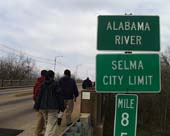 Crossing the Edmund Pettus Bridge into Selma. It was leaving Selma that the marchers encountered Alabama State Troopers. 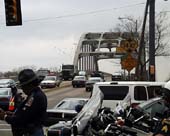 A heavy police presence secured the bridge in preparation of tomorrow's march. 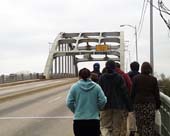 Marching across the bridge, following the path that Lewis and his followers took on March 7, 1965. 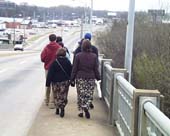 Reaching the crest of the bridge, one can finally see over to the other side. It is at this point that John Lewis saw the rows of Alabama State Troopers, and had to decide whether to proceed or turn back. 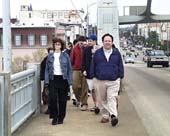 Crossing the crest of the bridge. 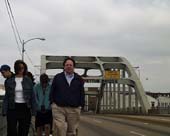 Another shot of the bridge 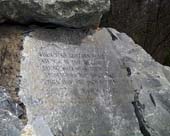 The beginnings of a new monument at the foot of the bridge where the violence took place. It reads: "When your children shall ask you in time to come saying what mean these 12 stones then you shall tell them how you made it over. Joshua 4:21-22" 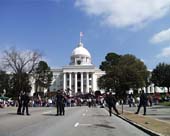 The Leage of the South rally from afar. 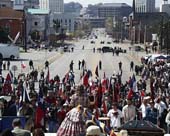 A shot of the rally, from behind. 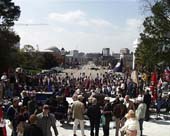 Another shot of the rally. 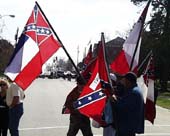 Rally participants, up close. 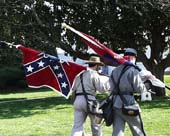 Many of the rally participants wore Confederate Civil War uniforms. 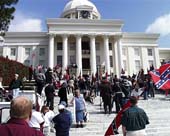 Yet another rally shot. 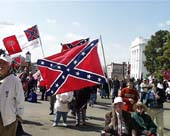 The focus of the rally was the Confederate flag. 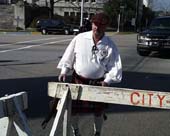 Another kind of Clan. ;) 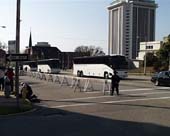 The congressional motorcade arriving. 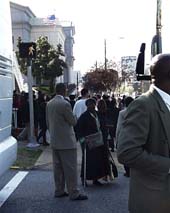 The Faith in Politics participants exiting their busses. 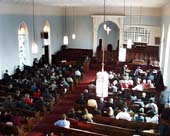 A shot from the balcony of the Dexter Avenue Baptist Church. 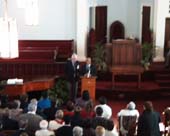 U.S. Rep. John Lewis speaking at the Dexter Avenue Church. 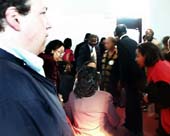 Waiting to meet Coretta Scott King. 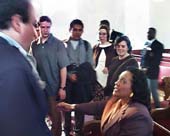 Joe, Zach, Alberto, Hillary and Teresa meeting Coretta Scott King, the widow of Martin Luther King, Jr. 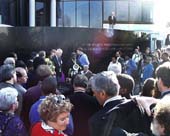 The congressional group surrounding the Civil Rights Memorial. 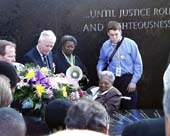 Placing a memorial wreath on the Civil Rights Memorial. 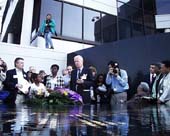 U.S. Rep. Amo Houghton (D. - New York) speaking at the Memorial. 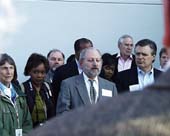 A Rabbi addressed the group. 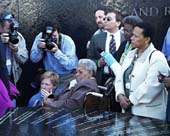 Mamie Till, mother of Emmett Till, a martyr of the Civil Rights Movement, looks on. 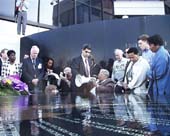 Mamie Till speaks to the group. 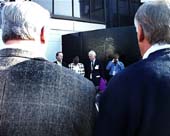 In closing, the entire delegation of congressmen, civil rights leaders and members of the media (and us!) join in "We Shall Overcome." |
|
Opinions expressed on this website do not necessarily reflect the views of the University of Michigan or any of its schools or colleges.